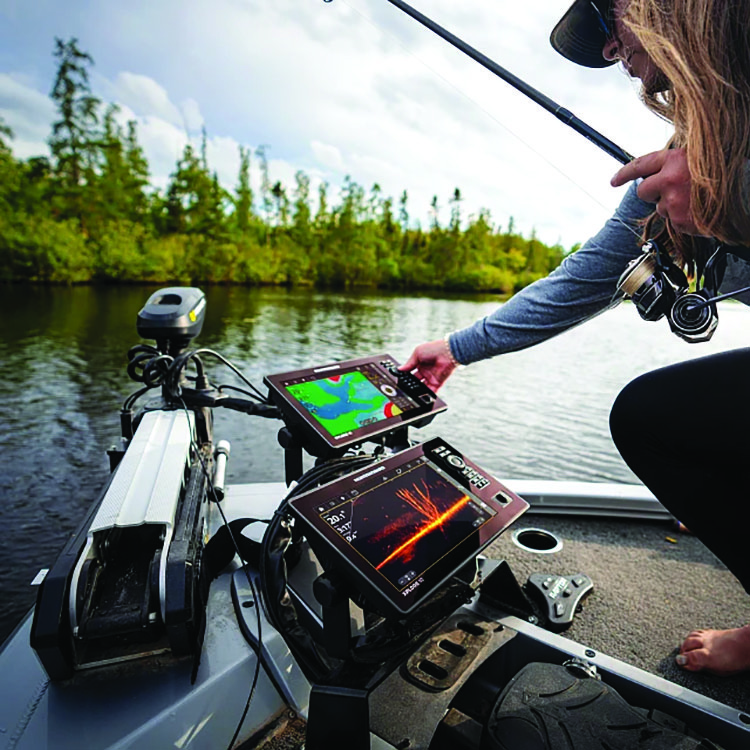Forward-facing sonar (FFS) has been around for approximately five years now and if you haven’t bought into it yet, you may have missed the biggest wave of advancement in bass fishing since side imaging. You do have that, right?
If you don’t then this article is probably not for you. However, if you are planning a FFS purchase or have recently made one and want to speed up the learning curve, read on.
So, you thought you needed forward-facing sonar to catch more fish and bought a unit and got it installed. Then you went to the lake, only to discover that operating forward-facing sonar looked way easier on YouTube. Sound familiar?
Well, you’re not alone. Many anglers now have FFS on their boats. Some are using it very effectively to find and catch fish not previously targeted before. Others are struggling.
In recent years, forward-facing sonar has stormed the fishing world and has become an effective way to win bass tournaments. It has helped anglers fishing for bass, crappie and striper become more successful. While it’s also a controversial subject among some anglers and it is changing the fishing industry perhaps for the worse, there is no denying that it has helped anglers catch more fish. As technology has evolved again, those who have embraced the change have discovered ways to make it even more helpful.
The purpose of this article is to help those of you with FFS better use it.
Let’s start with the set-up of your FFS unit, because no matter the brand, you’ll need to get it tuned in correctly to see fish and your bait.
Let’s start with the Gain control which is essentially sensitivity or volume. If you turn it up too high, you get feedback in the form of blurry images. If you don’t use enough, you cannot see fish or your bait. Most anglers agree 55-65% is about right.
You’ll also need to set your forward-facing range: as in how far you are scanning. Most bass anglers agree 80-100 feet is good for most casts. Crappie anglers rarely go beyond 50 feet.
Setting the depth range is important, too. Adjust that control to auto or 5 to 10 feet deeper than the targeted depth. You want as much screen (top down) as possible and as little of the lake floor (bottom up) visible as possible. This minimizes the “skinnying” or compression of objects and fish.
To make your images really stand out set the Color Gain control to 85 to 100%. This setting is what makes images pop. Use a lower setting (85 percent) for shallow conditions (15 feet or less) and 100 percent for 15 feet or deeper.
Adjusting the noise rejection setting can also produce a clearer screen image but obscure structure and fish. Lower settings permit the most detail.
Colors on your screen are highly personal. Some anglers like gold, others prefer black and green while others like blues. Try them all to what you prefer.
Now let’s talk about the different transducer angles for forward facing sonar.
Perspective mode allows anglers to find objects in shallow water. This mode will help locate fish habitat and structure more efficiently in depths of 15 feet or less.
Forward mode allows anglers to find habitat and structure as well but covers deeper depths those greater than 15 feet. Forward mode also allows for greater distances. Most anglers typically keep their unit set at 80 feet because an average cast is 80 to 100 feet in distance.
Now, let’s talk about using all of this on the water.
I rarely drive my boat around using the outboard with FFS on, scanning for fish, however, I’ve seen anglers do this. I just cannot bring myself to do that. I do use my MinnKota Ulterra Quest to scan for fish, constantly moving it back and forth as we are trolling, and if I do see something worth investigating, I slow down, putting on the brakes to so I don’t overrun the fish.
Next, I zero in on the target using MEGA Live and try to put a cast right at the fish and in the beam. As I always say to my clients: “All you have to do is make one good cast,” and that is important with FFS because the first cast is the best chance to get a bite. It’s also important to stay with the fish you spotted and are fishing for – be sure and track it like bloodhound!
There are many good baits to use when watching forward facing sonar. Jerkbaits, drop shots, jig and minnows and A-rigs are probably the most popular.
The jerkbait will often call up fish from structure, but sometimes they are just too deep and you have to go to them with the jig and minnow or drop shot.
What about the line and tackle best suited for FFS fishing? I definitely have found that you need to use the lightest line and lure weight as possible, so your baits sink fast enough (but not too fast) to reach where the fish are you are seeing.
On calm days, I will use a 2-1/2- to 3-1/2-inch shad profile, straight tail minnow like a Fitt NotAFluke on a 1/8- or 1/16-ounce VMC Moon Eye jig head. You are” tickling the nose of the fish” that often aren’t actively feeding with these lures. You don’t want to overwork your offering and light line allows for finessing baits. If the wind is over 10 mph, I would recommend you upsize to a 3/8-ounce jighead.
As far as the actual cast to a fish you see on FFS, here’s what I’ve learned works best: cast about six feet past the bass and let the bait sink until it’s one or two feet above the fish. Next, reel slowly, gently shaking the rod tip (usually a seven-foot spinning rod) to make the bait shimmy. Eight to 10-pound test is about right for me on Lake Anna.
And don’t underestimate how important it is to always see the fish AND your bait on your screen. Remember, if can see the fish and not your bait or vice versa, you’ll need to cast again – fast! You must keep the bait inches above the fish you see, so if you cannot see the bait, your cast is an act of faith and that’s not what FFS fishing is about.
When I was first using forward-facing sonar, it was an A-rig that really helped me. It’s easy to see on a screen, sinks quickly and attracts a lot of curious fish.
Now while we are heading into the spawn on most Virginia waters, traditional forward-facing sonar fishing will slow down. However, once fish move back off shore after spawning, you start “spotlighting” them again with the cheater box!
Look, if I can figure out how to use this new technology at age 56, you can, too! Don’t fight FFS sonar, embrace change.



